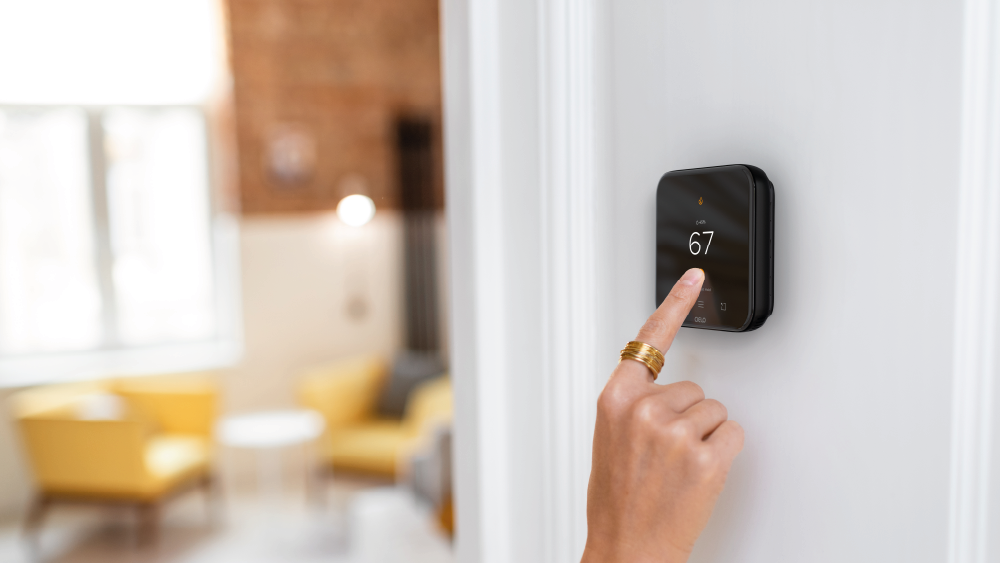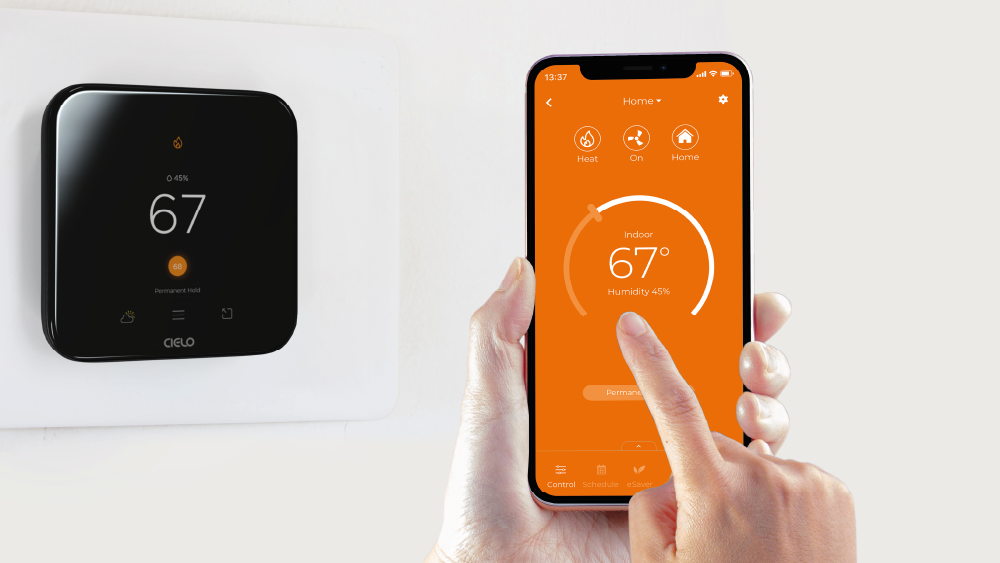
Key Takeaways
- A thermostat setback saves energy by adjusting temperatures when not needed, reducing heating and cooling costs.
- Smart thermostats automate temperature setbacks, saving energy while maintaining comfort.
- Setting your thermostat back 7-10 degrees from your routine settings for 8 hours a day can help you save up to 10% on your bills.
Managing energy costs can be a challenge, but there are surefire ways to reduce these expenses. One smart choice is adjusting your thermostat settings – even small changes can lead to big savings!
Going to be at work all day? Set back your thermostat.
Have a shopping trip planned? Turn down your home temperature.
Or headed out with friends for a small weekend getaway? You guessed it – make adjustments on your thermostat to avoid heating/cooling an empty house.
Over time, these little tweaks will accumulate into significant savings on your monthly energy bill.
Let’s learn how much savings can be achieved with a thermostat setback.
What Is a Thermostat Setback?
A thermostat setback is a strategy used to reduce energy costs while maintaining a comfortable home environment. The idea behind the process is to reduce the amount of energy needed for heating (or cooling) when it’s not absolutely necessary, such as late at night or when you are away from home. This can be done manually or through an automated system, depending on the type of thermostat used.
Manually setting back a thermostat requires manually changing the temperature settings in order to lower them at a certain time each day. Automated systems use sensors and timers to control temperatures in response to predetermined temperatures depending on your comfort level and preference.
Thermostat setback also involves keeping your thermostat at a lower temperature in winter and higher in summer. As your unit isn’t cycling on/off way too often, it helps to reduce your energy bills.
How Do Thermostat Setbacks Help Conserve Energy & Lower Your Bills?

Contrary to popular opinion, maintaining a constant temperature throughout the day without any adjustments will not help save energy. In fact, this way, your HVAC system works unnecessarily even when there’s no need, such as when your house is empty.
On the other hand, a temperature setback strategy will reduce how often your heating or cooling units run. When your HVAC isn’t running all day, you not only save on electricity bills but also reduce your carbon footprint. Even reheating or recooling your home would consume less energy than if the unit was running all day at a consistent temperature.
Smaller Temperature Difference Reduces Heat Loss or Gain
According to the law of thermodynamics, heat transfer occurs from a higher temperature to a lower temperature. This means that the greater the temperature difference between the outside and inside of your home, the higher the chances of heat loss or heat gain.
If it’s 50F outside and you have set your thermostat to 80F, more heat will travel outside, prompting your unit to kick into action more often. Similarly, in summer, the cooler your house is, the faster the heat transfers from the outside into your home.
When you setback your thermostat, you slow down the amount of heat transfer rate, and your HVAC won’t need to run as much. So if you turn your thermostat down to 70F, your home will experience minimum heat loss due to less temperature difference from the outside. Likewise, a higher set temperature in summer will reduce the heat flow from outside into your home, thus saving energy.
How Much Can You Save?
The amount that should be “set back” depends on several variables, including outside temperature, occupancy levels during normal operating hours, and any special conditions, such as humidity requirements in certain rooms.
The Department of Energy estimates that you will save 1% on your bills for every degree you set back your thermostat for a period of 8 hours or more every day. Meaning you can save up to 10% on your yearly heating/cooling costs.
The amount of money saved from implementing an energy-saving strategy like this can vary widely depending on the size of your home, weather conditions, usage patterns, etc but it can range from 10%-20% off total utility bills, which makes it an attractive option.
The Best Thermostat Setback Approach
With thermostat setbacks, you may feel like you have to compromise on your comfort to achieve savings. However, the best approach is to schedule setbacks for times when the home isn’t occupied. This eliminates any concerns about discomfort.
For instance, when you are out, you can set your thermostat 7-10 degrees back from your routine settings. You can easily set the schedules using a smart thermostat for central units or a smart thermostat for mini-splits in case of ductless systems.
You can also try turning down your thermostat when you are dozing off. This is referred to as a night setback. A range of 60-67F is considered the optimal sleeping temperature range. Our core body temperature experiences a dip in the evening so lowering the thermostat actually signals the body that it’s time for sleep.
How Can Smart Thermostats Effectively Implement Temperature Setbacks?

Although adjusting your thermostats for different times of the day saves money, it can be forgotten when you’re caught up. Plus, all these adjustments can get on your nerves. A smart thermostat or a smart AC controller can make your life much easier as they allow you to automate home climate control.
- Rather than spending money to heat or cool an empty house, you can set weekly schedules based on your routine. For instance, turning your AC off when you leave for work and on before you get back. The rest of the time, it’s either off or running at setback temperatures.
- You can also make changes on the go. Won’t be back home on time? Use your phone to set up your unit to continue running on setback temperatures.
- Smart thermostat devices can also detect when you leave the house by using sensors and your phone’s location. Once you are out, your HVAC unit automatically turns off. It will switch on when you are near your home.
- Some advanced smart thermostat models can learn your household’s schedule and adjust themselves automatically. For instance, they enter energy-saving mode when they detect no one’s home. You can also set your ‘Away’ temperature settings, which will automatically be implemented upon your departure.
Related: Do Smart Thermostats Save Money? – Your Thermostat Energy Saving Guide
Equip your HVAC system with smart features and achieve the perfect balance between comfort & savings.
Learn more
Things to Consider Before Turning Back Your Thermostat
Before you start turning the thermostat back or completely turning off your HVAC when you are out, here are some factors to take into account.
- Your comfort should always be your first priority. If setting your thermostat way back is affecting it, you can try making the 1-degree change every week till your body gets adjusted to it. Moreover, you can also focus on turning back your temperature when you are away or asleep to avoid discomfort.
- If you have children or the elderly at home who require a specific temperature range, setting a low temperature in the colder season and a higher one in summer may not work for you.
- Another top concern is extreme temperatures that can affect your home. For example, frigid weather can lead to frozen pipes if your HVAC is turned off for longer. In this case, the best solution is to use freeze protection mode. In this mode, your HVAC runs at low power, preventing your home temperature from falling below freezing.
- In summer, high humidity is a significant concern. Letting your house drift down in temperature way below your usual range may not be ideal. Prolonged periods of high humidity lead to mold, mildew, and fungi growth, leading to poor indoor air quality. For this reason, it is not advisable to completely turn off your HVAC. Instead, the best way is to set a temperature closer to the outside temperature so your unit continues to remove humidity while consuming minimum power.
Related: Ultimate Guide to Achieving the Ideal Home Humidity Levels!
Turning Back Temperature Settings for Savings
Although it may seem like a small change, setting your thermostat back just a few degrees can make a big difference in your energy costs. In this technique, you set your thermostat to a certain temperature before leaving for the day or going to bed, and when you return home or wake up, you set the thermostat back to where it was. This reduces your household’s overall energy consumption. Setting back your thermostat 10 degrees from your usual settings has been proven to be one of the best ways of achieving your energy-saving goal. In addition, using smart thermostats is one of the most effective ways to approach setbacks, as these devices can easily implement your settings without having to manually make adjustments every now and then.








